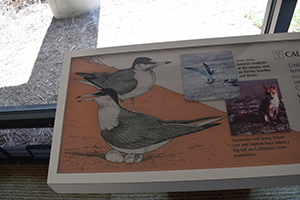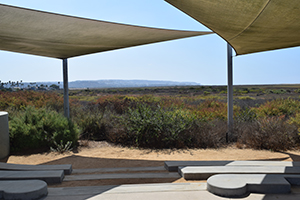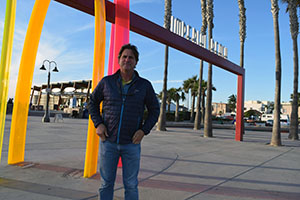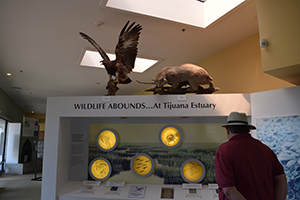 Schlepping and Schmoozing along the Interstate 5
Schlepping and Schmoozing along the Interstate 5
Chapter 5 (Exit 4, Coronado Avenue), Tijuana River National Estuarine Research Reserve
From freeway exit 4, go west on Coronado Avenue, which will change its name to Imperial Beach Boulevard; turn left onto 3rd Street, left onto Caspian Way. The Visitor Center is at the corner of 3rd Street at 301 Caspian Way.
 The tale of the Tijuana River National Estuarine Research Reserve is a classic good news/ bad news story, with some members of the Jewish community doing their best to further tip the scales to the good news.
The tale of the Tijuana River National Estuarine Research Reserve is a classic good news/ bad news story, with some members of the Jewish community doing their best to further tip the scales to the good news.
The 2,531-acre estuary occupies the southwest corner of the continental United States. Bordered on the south by Mexico and on the west by the Pacific Ocean, it is one of 24 wetlands in the United States that have been designated as a “wetland of international importance.”

Located under the Pacific Flyway within the city limits of Imperial Beach, the estuary hosts approximately 370 species of birds, including three that are on the endangered species list: the Light-Footed Clapper Rail; the California Least Tern, and the Least Bell’s Vireo. Two “threatened species”—a classification indicating less danger than that faced by “endangered species”—are the Western Snowy Plover and the California Gnat Catcher.
The southwestern-most corner of this southwestern estuary is known as Friendship Park at Border Field. Dedicated by U.S. First Lady Pat Nixon in 1971, this park – now operated by the State of California – was intended to be a place where U.S. citizens and Mexican citizens could meet, picnic, ocean swim, and celebrate together before returning to their respective countries. But now the U.S. and Mexican components are separated by fences.

Depending on tidal conditions and river flows, the estuary sometimes is infused with salt water from the Pacific Ocean and on other days surface water from the Tijuana River, which rises in Mexico 120 miles to the southeast. I use the term “surface water” rather than “fresh water” because for many decades sewage from Tijuana has been overflowing into the river which crosses the international border about five miles east of the estuary. This has often forced the beaches of Imperial Beach to be closed, while causing serious health concerns for people who work and play in this area – among them, lifeguards, Border Patrol agents, and surfers.
One prominent surfer, Serge Dedina, is the mayor of Imperial Beach, the small city in which the Tijuana River National Estuarine Research Reserve Visitor Center is located. Dedina is a secular member of the Jewish community. He has a doctorate in geography and is the founding partner with Wallace J. Nichols of the environmental group Wildcoast, which began work in Baja California and has made eliminating the sewage from the Tijuana Estuary a priority.

“The mythology is that this is a wet-weather problem, but Tijuana is expanding so much and its sewage system is collapsing so much, it has become a year-round problem, whether the weather is wet or dry,” he told me in a 2017 interview. “We have an increasing number of spills into the Tijuana River and into the canyons along the border, a whole series of spills that happen all the time.”
Congress voted to spend $300 million toward fixing the problem, which was announced at a well-attended press conference in 2020 that Dedina attended with San Diego County’s five congressional representatives, then including Rep. Susan Davis, D-San Diego, who retired in January 2021 after serving 20 years in the House of Representatives. (Davis, who is Jewish, was succeeded by Sara Jacobs, D-San Diego, who also is a member of the Jewish community. Jacobs serves on the House Foreign Affairs Committee.)
While some progress has been made, smelly sewage befouling the Tijuana Estuary and the beaches of Imperial Beach continues to be a recurring problem. In response, Imperial Beach, San Diego, and nearby municipalities have sued the United States government, saying it must do more, and spend more, to stop the international flow of effluent. At the same time, Dedina has chided Mexican officials to spend more on their side of the border – at one point drawing an unfulfilled demand from a former governor of Baja California for an apology.
Outlining the problem to a San Diego City Council committee, Dedina said that in the year 2020, sewage forced 300 days of beach closures. Other beaches farther north along the Silver Strand – a narrow strip separating the Pacific Ocean from San Diego Bay – were closed as many as 150 days, he said.
San Diego City Councilmember Vivian Moreno lives in San Ysidro, which is a close neighbor of Imperial Beach. She said the sewage overflows adversely affect a number of communities within olfactory range of the river. “It’s absolutely suffocating,” she said. “Absolutely suffocating, and not only communities like the one I live in San Ysidro, but Nestor and Egger Highland. They have been living with the odor of, you know, raw sewage just infiltrating their home.”
In September 2018, the Asversa subsidiary of the ODIS company of Petach Tikvah, Israel, signed a $77 million agreement with the government of Baja California to build a sewage treatment plant in Tijuana that would pipe treated water along a 65-mile aqueduct to irrigate the wine-producing Valle de Guadalupe (Guadelupe Valley) region. That project, with its salutary impact on the sewage issue, was in progress as of September 2021.
On its website, ODIS Asversa offers water conservation tips that are good ideas for residents of both countries: 1) Just serve the water you think you will drink. 2) Make sure to turn off the faucets properly. 3) Fix the leaks. 4) Shorten your shower time and turn off water while soaping. 5) Turn off water while brushing your teeth, soaping your hands, or shaving. 6) Use a bucket and sponge to wash the car. 7) Water plants with rainwater or at night.
*
Next, Sunday, February 6, 2021: Exit 5A (Palm Avenue), Loews Coronado Bay Resort
*
This story is copyrighted (c) 2022 by Donald H. Harrison, editor emeritus of San Diego Jewish World. He may be contacted via donald.harrison@sdjewishworld.com
